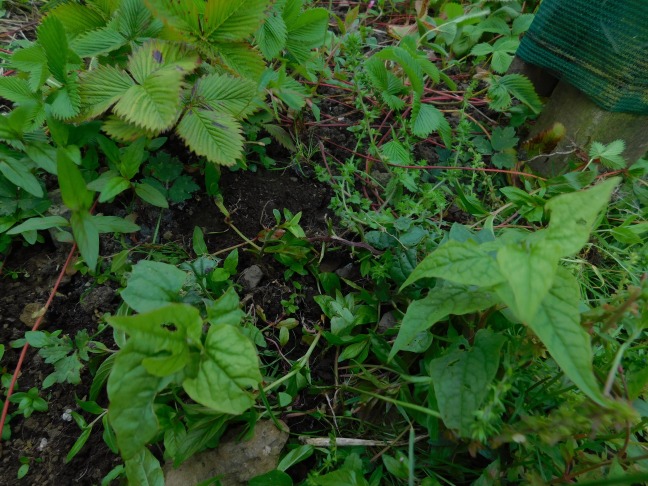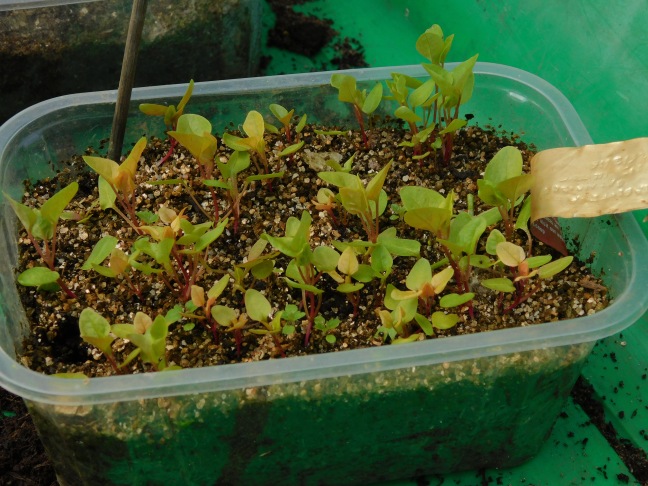
I’ve had a Hablitzia Tamnoides plant for about 18 months now. To say it is not thriving, would probably be pretty accurate. It’s a relatively unknown plant in the UK, at least until quite recently. Originating from the caucasus region, it is (supposed to be) a vigorous scrambling perennial plant, growing to about 6 ft with tasty leaves that can be cooked and eaten like spinach. Steven Barstow (http://www.edimentals.com/blog/?p=8606) has helped to popularise the plant with his ‘around the world in eighty plants’ book, which I heartily recommend by the way. My plant came from Alison Tindale of backyard larder (http://backyardlarder.co.uk), as a swap for some local Skye plants, and I planted it in the tea garden, where I thought it would be quite sheltered. As it turns out the tea garden hasn’t been as sheltered as I’d hoped. Also, I’ve since found out it’s native range is in limestone cliffs, so it prefers quite an alkaline soil.
(edit: I seem to have made up the limestone based on this comment from Steven Barstow, https://m.facebook.com/story.php?story_fbid=10154986079450860&id=655215859
I think I just assumed the cliffs in the picture were limestone. Having done some hasty research online https://www.britannica.com/place/Caucasus, does mention limestone, so perhaps my guess was right. Alison Tindale also says it dislikes acid soils (which seems to bourne out by my experience) so I think I have added 2 and 2, whether my answer is right is luck rather than judgement! What Stephen actually says in his book is that ‘It is found in spruce and beech woods, amongst rocks and in ravines and along rivers’)
It also benefits from quite a fertile spot. I don’t think the tea garden is particularly fertile, but relatively good for round here. Because I was so keen on growing this plant, I had also obtained some seed from Mandy at incredible vegetables (http://www.incrediblevegetables.co.uk) this spring, and got lots to germinate.

Potted on, they soon outgrew the fertility in their little pots and turned quite yellow. I’ve since potted them on again, and so far they are looking a bit more happy. I decided to make a ‘habby bed’ to make my hablitzia happy. This is in the shelter of the workshop by the drive. I dug out the soil and rocks as deep as I could (not very deep – a foot or before I hit bed rock). I then back filled with builder’s rubble (some of the old render from the byre which was falling off). On top of this I put compost from last year’s compost heap which was rather full of wood ash from the stove, so hopefully both nutritious and low in pH. Having mixed these two together (difficult with the stones) I topped the lot with not quite ready bracken compost, which hopefully will be relately weed free as well as adding to the nutrients in the longer term. I’ve planted three of my new hablitzia in the bed and so far they are just sitting there! Hopefully next spring I should see them putting on good growth in appreciation. I need to think about some sort of climbing frame for them, since they should now grow quite tall.

This week I finally got round to doing a pH test on the soil here. I’m not sure why I hadn’t done it before. I think I had just gone on the gut feeling that it is quite acidic, without needing to put a number on it, and let’s just say I was right! The hydrangea here can have lovely blue flowers, and rhododendron thrive. I’m a bit surprised now that anything else grows – it just goes to show that plants don’t read books! I took a soil sample from approximately the centre of the tree field between the royal oaks, and the pH came out as very acidic. I tested the soil in my happy habby bed as well, and at this early stage my terraforming has been successful as it has come out as alkakine. It will be interesting to see how this changes over time. Hopefully the lime from the render will keep the worst of the acidity away. If necessary, I have a ready supply of ash from the house fires which could be used to top up.
I think I will do some more pH testing nearer the house to see if there is a difference in the cultivated areas. They may have been ‘improved’ by previous gardeners, or from lime leaching from the buildings. I do occasionally dig up what seems to be a bit of chalk, so the land does seem to have been modified in the past. I can’t think of any other reason for rock chalk to be lying about anyway.



This is really useful! I’ve just had some seed from Mandy too, and they are just starting to germinate (which surprised me as I thought they needed a cool period). I will bear all your careful research in mind when preparing the soil for them. Thank you!
LikeLiked by 1 person
Yes I also thought they needed a cold period (I gave mine a week in the fridge to be on the safe side). As I said – plants don’t read books! I gather they’ll do better once they are in the ground (unless your soil is as acid as mine). Good luck.
LikeLike
True, plants don’t read books. I’m sorry for you will acidic soil, though – a bit of a challenge there!
LikeLiked by 1 person
As I said, I’m surprised how acidic it turned out. I have managed to grow things, but now I can blame my soil on my failures! 😊
LikeLike
Yes, always good to know it’s not you 😊.
LikeLiked by 1 person
I have never done a soil test but I am quite sure my soil is acid, peaty soils are acidic, I have read to look at what grows naturally as it gives an indicator to type of soil and all the weeds and wildflowers around here like an acid soil, horsetail, sorrel, etc. also I have lodgepole pines planted by previous owner, they love a low nutriant acid soil apparently and of the trees I planted the acid lovers like downy birch and alders are growing and the ones I lost most like a neutral or alkaline soil,
I started liming some areas and can see a difference not only in the plants I planted but also a noticable difference in the number of acid loving weeds, there were less, apparently liming an acid soil helps release nutriants that are locked in, I have noticed that the low nutriant acid soil is more of a hindrence to plants growing than the winds that most people told me was why plants didn’t grow well here,
your wee plants look snug in their new bed with the drystone wall protecting them, I hope your hardwork pays off and you get a good crop next year, Frances
LikeLiked by 1 person
Thank you Frances. I’ve done a few more tests around the garden area, and the pH does vary quite a bit. It’s interesting that you found that liming the soil made more difference than providing shelter. I guess it depends on what you are trying to grow, but I shall certainly bear that in mind in the future.
LikeLiked by 1 person
yes it does depend on what is growing and conditions the plant likes, I do not lime near the acid loving plants like the downy birch, also what your soil is like, mine is very peaty, I have sometimes collected the solid lumps of peat that I find when working with the soil and burn them as fuel, they are like rocks or stones but light in weight so are solid peat, from some of what I have read on your blog you seem to have a grazed soil that has been fertilized with sheep droppings so it will be more fertile and loamy than mine,
feeding plants with what they need is what I am finding key to better growth, I have spent a lot of time on the internet reading up about types of soil and what food a plant needs, one of the gardeners on GQT once said it’s like people they grow better with a good diet, I read that bonemeal is good for root growth and so (though I am veggy, my plants aren’t) I bought some and started using it in the planting hole when I planted, I immediately noticed a difference, I only used it when planting, recently I have been using mycorrhizal fungi, it’s still in my garden testing phase so I can’t yet comment on how well it is working, I do make compost but can never make enough and I have broken down a lot of turf which apprently becomes loam, however I have found soil and food for plants is the most important thing, Frances
LikeLiked by 1 person
I’ve heard that where sheep graze, acid soil becomes more alkaline. It may be rain dripping from coats. Maybe worth looking into, to get better soil for Hablitzia.
LikeLike
Thanks for the suggestion Margaret, I hadn’t heard that. Unfortunately sheep and trees don’t mix. I have done some more measurements around the holding since this post and the lowest pH was the one from the centre of the tree field which had been grazed by sheep for several years previous to us planting the trees. The lowest pH i.e. the least acid was inside the polytunnel. Thus had been either improved by previous gardeners, or with lime washing from buildings
LikeLike
Yes my soil is more a mineral soil than peat. Unlike many of the outer isles and south Skye, the rock in Glendale is volcanic lava flows and in the valley the soil is a light silty loam. I’m not sure whether sheep add or detract from the minerals in the soil, bearing in mind they build up lamb bodies that are exported, but in this area are fed supplemental feeds as well. Any soluble nutrients will also soon be washed out….
Bonemeal would also add calcium, so tend to raise the pH as well which may help the plants. I’ve tried using some mycorrhizal fungi as well. You can get an ericacious fungi mix specifically for acid soil loving plants as well. I haven’t done with/without testing, so can’t tell whether it made any difference however. I just used it on my most precious plantings until I ran out!
I think not having enough home made compost is one of the ‘rules of gardening’ like ‘weeds expand to fill the space available (and then some)’ and ‘The best plants to eat are those that the slugs also like’.
LikeLiked by 1 person
I found good results supplementing (well, more like using as an alternative substrate) with a very high silica and calcium rich rock powder : https://mortaltree.blog/2017/03/31/achieving-hablitzia/ I also sprayed with watered down honey to keep the bacteria off. The situation you have provided yours looks much like the one mine (correction: my client’s) finally flourished in. Now to just do the same in MT! Thanks for sharing.
LikeLiked by 1 person
I’ve added an update onto your page comments. I think sheltered and high pH are key. I still need to sort out some trellising for them to (hopefully) scramble up next spring!
LikeLiked by 1 person